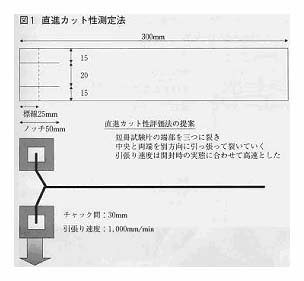Translator's note: Line-breaking packaging material is an easy-open packaging material with practical use value, which deserves our high attention. This article not only introduces a kind of packaging material made of non-woven fabric and has straight-line crack performance, but also proposes an evaluation method of easy-opened packaging material with straight-line crack performance. It is of great reference value and is specially translated and recommended to readers. The importance of straight seams In the trend of high-functional packaging and high added value, it is important to improve the easy-openability of packaging. Protecting the contents inside the package is the first function, while opening it requires easy opening. Protection of contents and easy opening are two opposite aspects. How to solve this problem is a challenging aspect of functional packaging. The general feature of a plastic film is that it is easy to tear by a stress concentrated incision, and if there is no incision, it is not easy to tear even if it is torn. As a packaging material, it is often desirable to have excellent protection functions and to be able to open and close where it needs to be cracked. This is one of the characteristics of the packaging material. In the trend of high value-added products, proposals have been made to further impart additional properties to the film. However, in actual use of such functional packaging materials, the purpose of these functionalizations is not necessarily the same. When you get the function is not the same. However, these different systems are not discussed. The additional functions aiming at easy Kaifeng specifically include the following points: (1) The tear in the direction of the desired tear should be a straight line break; (2) The tear propagation force at the time of opening should be small; (3) Freedom to crack anywhere; 1. It is very important, no matter who has experience: When we open the seal and spread it in an undesirable direction, the contents will leak or be damaged. This is undesirable. Therefore, it is extremely important that the cracks are straight-lined and that the inner surface is removed without force; In fact, as far as the straight-line propagation of cracks is concerned, there is no universal method for the quantitative evaluation of this element as long as it is a sensory discourse. The author defines the physical properties of the cracks as "straight-line cracking" (originally referred to as "straight-forward cracking"). He first proposed its quantitative evaluation plan. 2. The propagation load is evaluated by standard test methods such as the standard single table tear strength test and the tear strength test of the trapezoidal test tear strength test method. From the perspective of easy-opening, the lower the tear strength, the better, but tearing with too little force, but it is difficult to open because of too little force. 3. It is possible to open the seal freely even if it is not cut out from the position. However, it can be easily torn open at the base material without a notch, and it is related to the problem of easy opening. In the case of applications such as strapping, it is important to tear open freely at any point in the field, but consideration should be given to adapting the protection function to the packaging. "Linear rip" evaluation method In addition, after using the tensile testing machine to measure, it is also possible to obtain information on the load transmitted by the crack at the same time. The linear cracking property is given by the non-woven fabric The non-woven fabric “ミラィフ†is a special non-woven fabric manufactured by Shinji Ishigaki using its own stretching arrangement technology. It is a latitude and longitude fabric produced by longitudinally arranging longitudinal non-woven fabrics and other horizontally arranged non-woven fabrics by using different technologies. The right angle cross composite nonwoven fabric is very different from ordinary chaotic FIBER nonwoven fabrics. The protagonist of this article is the vertical non-woven fabric “タテミラィフ†of Nippon Ishigaki Co., Ltd. whose internal fibers are longitudinally arranged. When it is composited with a film, the propagation direction of the crack can be controlled in the direction of the longitudinal fibers when the film is opened. For the composite film, OPP film widely used in packaging can be used. Since the OPP film is a stretched film, the residual stretch rate is low, and since it is not stretched and easily cracked, it is most suitable as a combination target of helium, but it is not necessarily used. OPP. Photo 1 shows the opening condition of the packaging material with longitudinal straight line cracking. From the point of view of the photo, it can split straight. Taking 15g/m2 OPP and longitudinal nonwoven fabrics as an example, a dry composite product was used for comparison with the existing easy-openable packaging materials using the aforementioned evaluation scheme. Electric Water Heater and related supplies Electric Water Heater,related supplies,Water Heater Bishan Ceramic Import And Export Company Limited , http://www.ll-ceramic.com
The author proposed the "linear cracking" evaluation method shown in Figure 1. Take a strip of 50mm in width and 300mm in length. Cut one end into 2 cuts and cut into 3 sections. Use the testing machine to reversely pull the two ends of the two sides and the end of the middle piece. Pull the two pieces on both sides to make the middle One piece is separated, and the pulling rate is about the same as people's unsealing speed. Generally, the setting is 1000mm/min, and the cracked test piece results are shown in Fig. 2. "Linear rip" good substrate, divided into three beautiful three rectangular, if the "linear split" is poor, the middle strip becomes thinner, then determine the width of the strip from the start of the gap 50mm, The change in width is used as an indicator of "linear cracking." 

(to be continued)